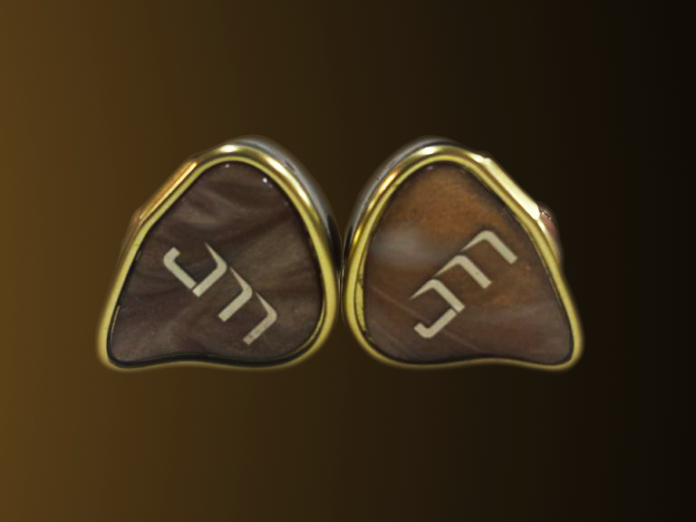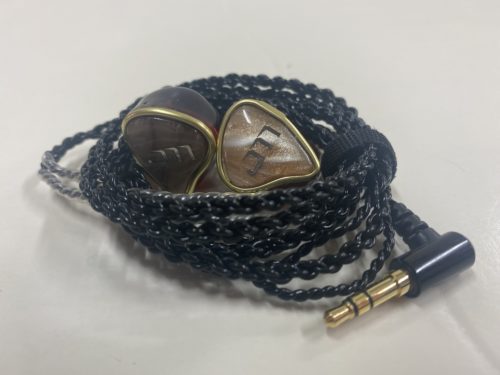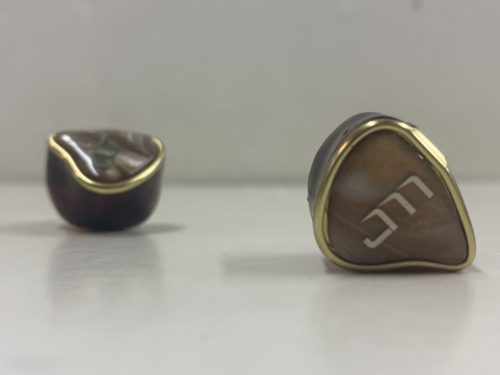I have yet to hear anything from Jomo Audio until now, and I am excited to experience a new IEM without any expectations. The Cappuccino is a $299 IEM that I have spent quite some time with, and I am excited to share my thoughts. Can this single-driver IEM provide a satisfying sound?
What You Get
- Universal in-ear monitors
- Premium carry case
- Soft mesh protection pouch
- Silver Plate OFC Copper Stock Cable (3.5mm, 1.3M, L plug)
- Carbon fiber print product ID card
- Gold plated 1/4″ adaptor
Look and Feel
When IEMs have a specific theme in mind, it usually makes for an eye-catching design. With the S100’s Cappuccino name, the artistry should reflect that and does successfully. What you get is a familiarly shaped IEM with a rare color pallet that has a nice aesthetic flourish. The fit isn’t bad either, and if I had to nitpick, I think the spout could have been made a bit shorter.
Design
A single 10mm dynamic driver makes up the Cappuccino’s interior structure. It uses an LCP ultra-thin diaphragm and a double harmonic acoustic chamber. With this design, Jomo hopes to make the most out of its single driver with good control and efficient sound propagation.
– Frequency Range: 20Hz ~ 20KHz
– Impedance: 15 Ohms
Soundstage
The Cappuccino gives you a wide open soundstage that knows when to completely surround you. In most tracks, the Cappuccino has a traditionally forward stereo field, with great left and right balance and a big image to get a full sense of the music. I tested a couple of metal and synth-pop tracks to get this sensation, but I noticed the Cappuccino really started to come alive with instrumental scores and soundtracks. Andrew Hulshult’s “Dusk” soundtrack marries ambient instrumental sections with mighty metal mayhem, which this IEM handles with excellent layering and spatial clarity. There’s a hard limit to how far the soundstage can reach, but its performance organizes all of the sound elements in a satisfying way.
Low End
There’s some good depth to be had in the low end of the Cappuccino. Its frequencies resonate from below your jaw, providing a solid foundation to the timbre. Clean textures are present with some sub-bass groove that enriches the tone even further. The mid-bass is going to punch the hardest though, with snappy transients that best highlight the finesse of this single dynamic unit. A fun bass experience to be sure, and one that also doesn’t exaggerate too far.
Mids
While the low-mids and fundamental mids feature a solid body of tone, the frequency response takes a significant dip in the upper mids. Certain instrumentals hit hard, but fail to show any crispness, which harms some vocal performances in this range. They don’t appear unclear, but not much energy or fidelity is featured in their presentation. This is why more instrumental-focused tracks receive the most attention. It makes the Cappuccino appear a lot more full, and for the most part, it is.
Highs
Even though I like my treble with a bit more bite, the sustained clarity in the highs is admirable. There actually is some present shine to certain elements, but the Cappuccino is mostly concerned with preserving a tasteful response. It is missing some height but makes up for it in clarity and coloration.
Summary
The Jomo S100 Cappuccino is an exciting listen. Its sound signature has some flaws, but for the most part, its timbre is energetic and it keeps the performance consistently enjoyable. It possesses an easily gripping bass and lower midrange that showcases a strong body of sound, while not cutting back on its treble. Throw in a solid design, and the Cappuccino becomes a sure bet for $299.
| Pros | Cons |
|
|
The Jomo Audio S100 Cappuccino is available at Audio46.
Compare the ranking of various headphones, earbuds and in-ear monitors using our tools.
Discuss this, and much more, over on our forum.
---MAJORHIFI may receive commissions from retail offers.



















